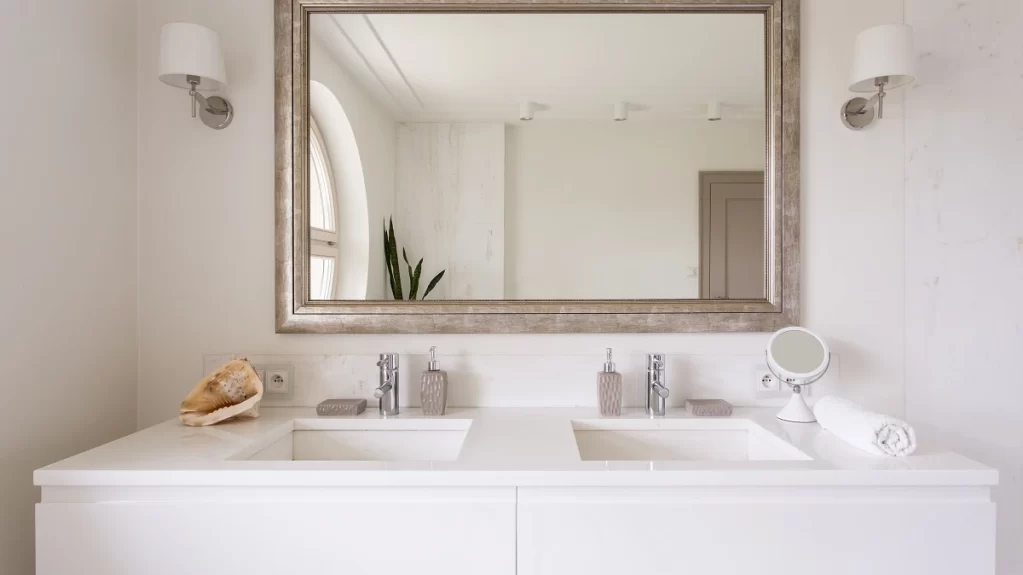When our bathrooms were more about practicality than attractiveness, the standard setup was a vanity with a single sink. Add a toilet, medicine cabinet, and shower, and you have the typical bathroom. Today, bathrooms are more about comfort, style, and convenience, and many feature larger vanities with double sinks.
Are beautiful bathrooms with double sinks just a luxury, or are two sinks better than one? The only way to find out the answer is to learn how to change a one-sink vanity into a two-sink vanity—or you could ask your neighbors. We’ll make our case and even show you (spoiler alert!) how to change a one-sink vanity into a two-sink vanity.
How to Install a Two-Sink Vanity
If you install a two-sink vanity in your bathroom, you’ll need carpentry and plumbing skills to get the job done right. For most DIYers, the plumbing part of installing a double-sink vanity is the most challenging. Whether you choose to do the tear-out and install yourself and hire a plumber for the tricky details or tackle the whole job, here’s how the process works:
- Shut off the water supply to the sink and disconnect the plumbing.
- Remove the vanity, being careful not to damage any plumbing or walls.
- Rough in the two sets of water lines and drains.
- Cut out the back of the vanity for plumbing if needed.
- Put the vanity in position and ensure it’s level side-to-side and front-to-back.
- Use shims to get the vanity and cabinet-level if needed.
- Attach the new double-sink vanity to the wall and studs using 3″ cabinet screws.
- Install the faucets and connect the water lines and plumbing to the sinks.
- Caulk the gaps where the vanity meets the wall and let it cure for 24 hours.
When installing your new vanity and sinks, you may encounter needed steps other than those listed above. You may have to replace trim and baseboard sections or even use filler strips to fill in gaps, so be prepared to make these changes. Again, if the plumbing skills are outside your wheelhouse, investing in a professional plumbing installation may be best. If all goes well, you should be able to convert your single-sink vanity into a two-sink vanity in a weekend.
Once you’ve completed the project, you may notice your new double-sink vanity stands out because the rest of your bathroom didn’t get a makeover. You’ve done the hard part, so why not make your new vanity shine with a few other updates? Most bathrooms are small, so updates like new tile floors or beadboard accents are often inexpensive projects that can transform a tired bathroom into a sparkling wonder.
Single-Sink Vanities Vs. Double-Sink Vanities
If you’ve considered switching from one sink to two, you’ve likely realized that a two-sink vanity is larger than one with a single sink. You may have a vanity large enough to accommodate a second sink, but the technical difficulty can be pretty high for the average do-it-yourselfer. For most of us, a two-sink setup often calls for a new vanity.
You may have even picked out a new vanity or two and taken some preliminary measurements. If you’re like most DIYers, you may think if your new vanity fits the space, you’re good to go. But there’s a bit more involved. Switching from a single-sink setup to a double-sink vanity requires a few plumbing adjustments. You’ll need more plumbing for the second sink, so it’s essential to know the dimensions and other measurements of the new vanity before starting.
Many double-sink vanities are built with two sets of cabinets or a combination of drawers and cabinets, and some configurations are easier to plumb than others. For example, if you want to have more drawers than cabinets, the drawers will need to make room for the additional plumbing. Now that you know what you’re getting into when you switch from one sink to two, consider the advantages and disadvantages of doing it.
The Advantages of a Single-Sink Vanity
The traditional and practical one-sink bathroom does have its advantages, even though the layout is becoming a relic in new construction.
- Single-sink vanities are ideal for cramped bathrooms.
- A single-sink setup’s typical sink area and vanity surface are easier to keep clean.
- With minimal counter space, you don’t have to worry about a cluttered vanity.
- Replacing a one-sink vanity with another single-sink alternative is typically less expensive than switching to a double-sink vanity.
If you have a one-sink vanity and it’s working for you, maybe a double-sink setup isn’t necessary. You may still want to consider switching to a two-sink version if your vanity is dated or seems small compared to the size of your bathroom.
The Advantages of a Two-Sink Vanity
If you have the room, a double-sink vanity can be better than a single-sink vanity—especially if you have a busy household. Here’s why two sinks are better than one:
- A two-sink vanity allows two people to get ready for work or school simultaneously!
- Double-sink vanities typically offer more storage with cabinets and drawers.
- A larger vanity provides more counter space to keep essentials close at hand.
- Two-sink vanities can help balance the look of a larger bathroom.
We bet you can come up with your own reasons why a two-sink bathroom is a good investment. As long as you have the space and the construction and plumbing skills, this project can be worth your time.
